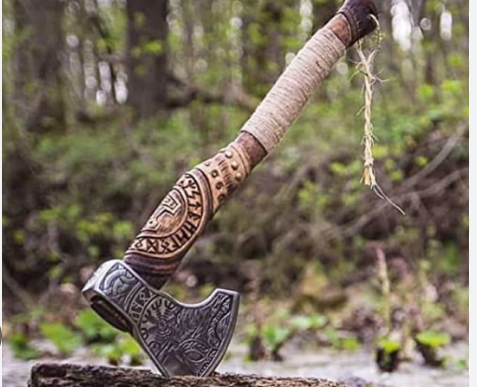Viking Axes in the Modern World: Usage and Cultural Influence

The Viking Age may have ended over a millennium ago, but the legacy of the Vikings lives on, particularly through their iconic weapon: the axe. Known for their strength, practicality, and symbolic meaning, Viking axes have found a place in the modern world far beyond their historical use in warfare and daily tasks. Today, these ancient tools are embraced in various ways, from practical applications and hobbies to cultural symbols and entertainment. This article explores how Viking axes are used and appreciated in contemporary society.
1. Historical Reenactments and Living History
One of the most popular modern uses of Viking axes is in historical reenactments and living history events. Enthusiasts and historians come together to recreate battles, daily life, and significant events from the Viking Age, using authentic or replica weapons, including axes. These reenactments aim to educate the public and provide a glimpse into the past, offering a tangible connection to history.
In these settings, Viking axes are used in mock combat, where participants follow strict safety guidelines to avoid injury. The axes, often blunted or made from less dangerous materials, serve to illustrate the combat techniques and strategies used by Viking warriors. Living history groups also use Viking axes for demonstrations of traditional craftsmanship, such as woodworking and metalworking, showing how these tools were an integral part of Viking daily life.
2. Martial Arts and Training
The practical and versatile design of Viking axe has made them a popular choice in the growing field of historical European martial arts (HEMA). Practitioners study and revive historical fighting techniques, often incorporating Viking-style weapons, including axes, into their training. HEMA clubs around the world offer classes that teach the use of Viking axes in combat, emphasizing historical accuracy and effectiveness.
Training with Viking axes provides martial artists with a unique perspective on balance, power, and technique. The use of axes in combat requires a different approach compared to swords or other weapons, focusing on leverage, body mechanics, and the weapon's distinctive design features, such as the bearded or broad blade.
3. Modern Craftsmanship and Axemaking
The craftsmanship of Viking axes has inspired modern blacksmiths and toolmakers, who create replicas and contemporary versions of these historical tools. The resurgence of interest in traditional crafts has led to a growing community of artisans dedicated to preserving and advancing the techniques of Viking axemaking.
Modern axemakers often blend traditional Viking designs with contemporary materials and methods, producing axes that are both functional and artistic. These axes are used not only by historical enthusiasts but also by outdoorsmen, woodworkers, and collectors who appreciate the durability and aesthetic appeal of a well-crafted axe.
4. Sports and Recreation: Axe Throwing
Axe throwing has become a popular recreational activity and competitive sport in recent years, with Viking-style axes often being the weapon of choice. This modern pastime draws on the historical use of axes as throwing weapons, transforming it into a fun and engaging challenge. Axe throwing venues have sprung up in cities around the world, offering a unique experience for participants of all ages.
In competitive axe throwing, the design and balance of the axe are crucial for accuracy and consistency. Viking-style axes, with their distinctive shape and weight distribution, are favored by many for their reliability and the added thrill of connecting with a piece of history.
5. Cultural Symbols and Popular Media
The image of the Viking axe has become a powerful cultural symbol, representing strength, resilience, and a warrior spirit. This symbolism is widely used in modern popular media, from movies and television series to video games and literature. Viking-themed entertainment often features characters wielding iconic axes, evoking the legendary prowess of Norse warriors.
The Viking axe has also found a place in fashion and jewelry, where miniature axes or axe motifs are incorporated into necklaces, rings, and clothing. These items serve as personal symbols of strength and connection to Viking heritage, appealing to those who admire the boldness and independence associated with Viking culture.
6. Commemorative and Decorative Uses
Viking axes are often crafted as commemorative items, celebrating Norse heritage, historical events, or achievements. Decorative Viking axe for sale are popular among collectors and history enthusiasts, who display them as part of their home decor or in dedicated collections. These axes are often intricately decorated with runes, knotwork, and other traditional Viking symbols, showcasing the artistry and cultural depth of the Norse people.
Conclusion
The Viking axe, once a tool of survival and a weapon of war, has found new life in the modern world. Its practicality, historical significance, and symbolic power continue to captivate people, making it a versatile and enduring presence in contemporary society. Whether used in historical reenactments, martial arts, craftsmanship, sports, or popular culture, the Viking axe remains a testament to the lasting influence of the Vikings. It serves as a bridge between the past and the present, reminding us of the enduring legacy of a people who left an indelible mark on history.
- Art
- Causes
- Crafts
- Dance
- Drinks
- Film
- Fitness
- Food
- Jocuri
- Gardening
- Health
- Home
- Literature
- Music
- Networking
- Alte
- Party
- Religion
- Shopping
- Sports
- Theater
- Wellness
- IT, Cloud, Software and Technology


